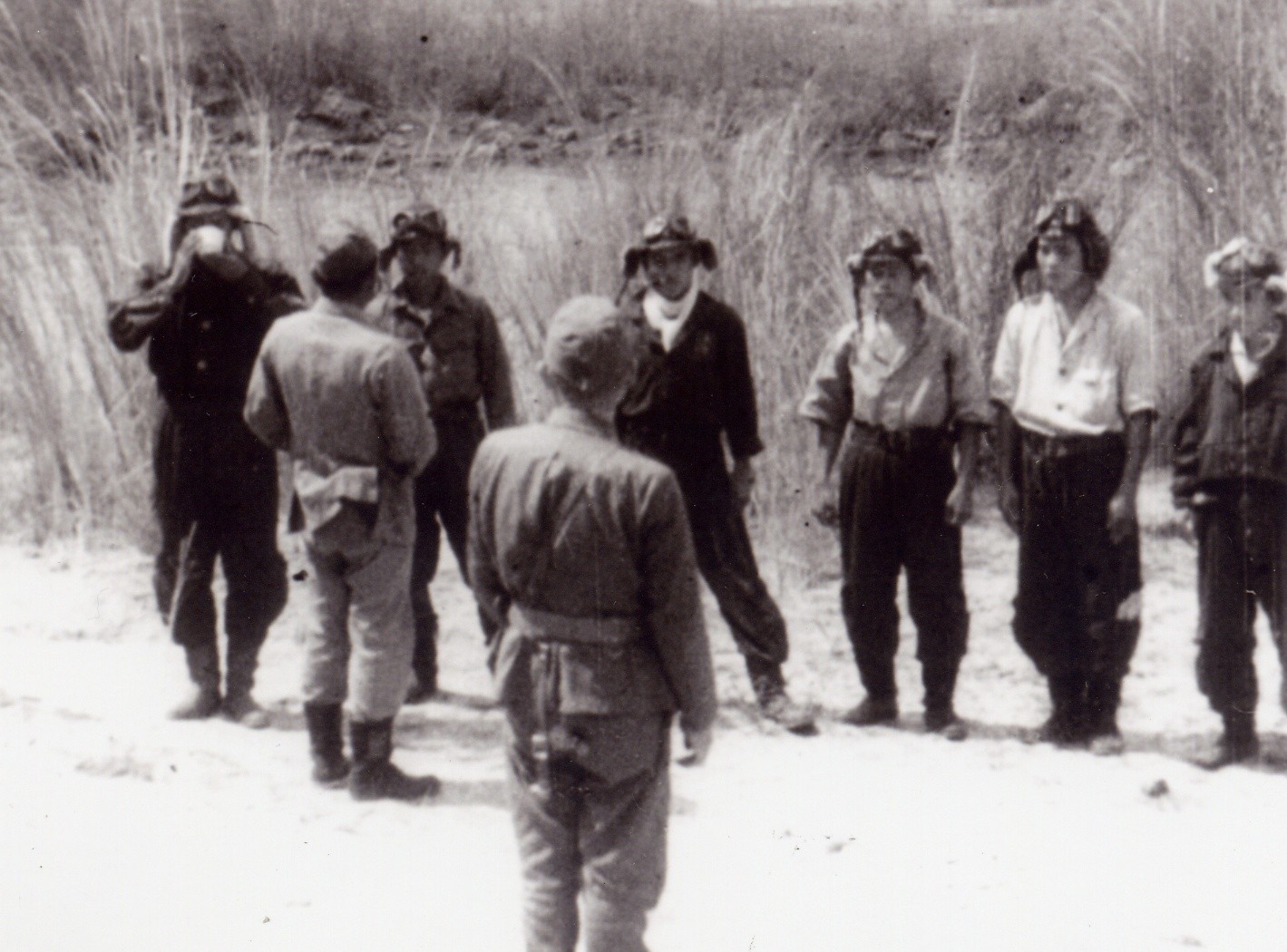
25 October 1944: During The Battle of Leyte Gulf, the Divine Wind Special Attack Unit (Shinpū Tokubetsu Kōgekitai, or 神風特別攻撃隊) carries out its first mission, an attack on two task groups of United States Navy escort aircraft carriers near the island of Samar in the Philippine Sea.
Prior to the Kamikaze attack of 25 October 1944, there had been other suicide attacks by Japanese pilots, possibly beginning as early as the attack at Pearl Harbor, Hawaii, 7 December 1941. But the idea of intentional suicide attacks was proposed by Captain Motoharu Okamura, IJN, and studies began 15 June 1944.
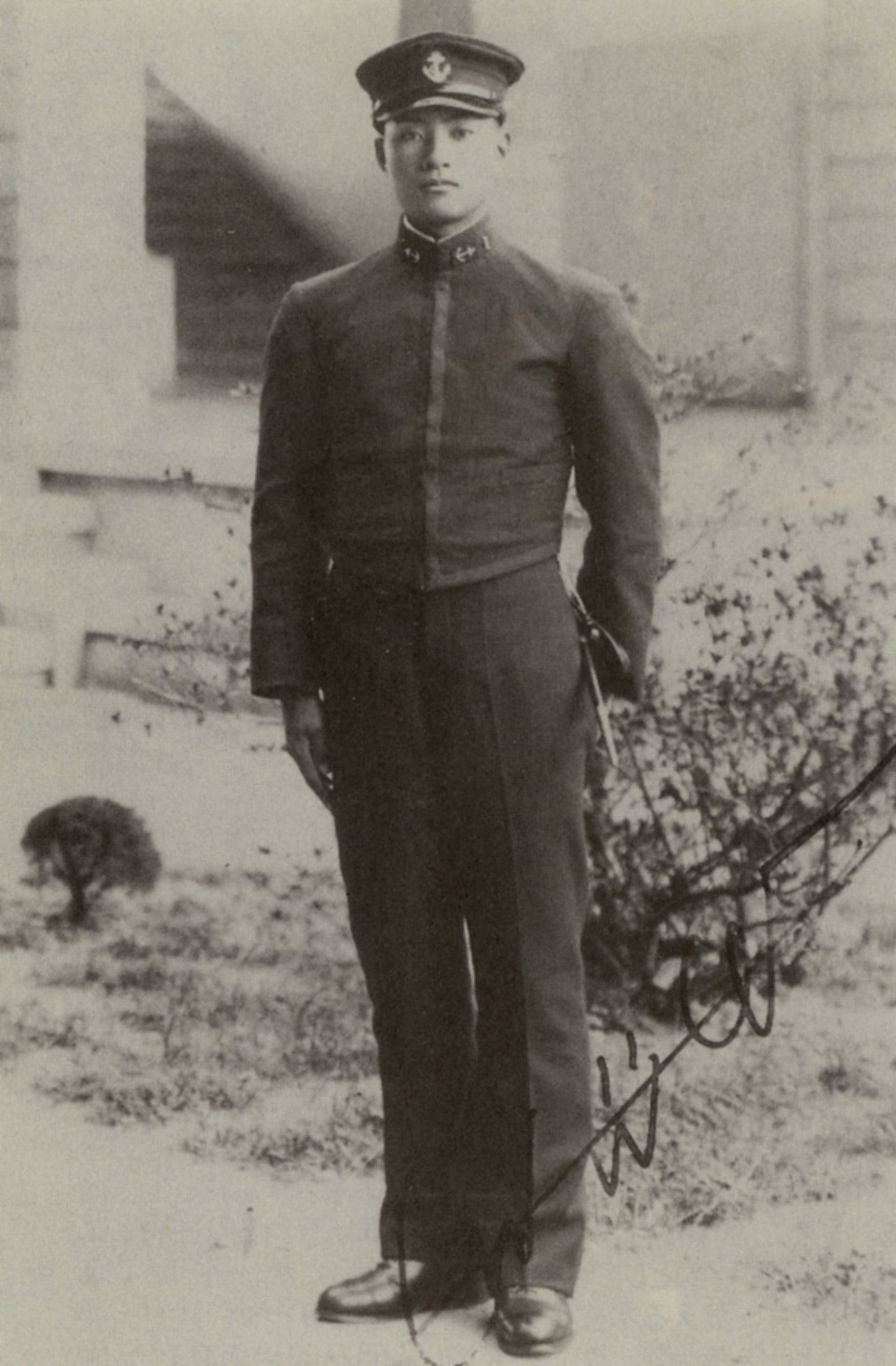
The first unit of 23 pilots, Unit Shikishima, was selected by Commander Asaichi Tamai. Lieutenant Yukio Seki (29 September 1921–25 October 1944) was appointed the unit’s commanding officer.
At 7:40 a.m., 25 October, six Japanese airplanes from Davao, Mindanao, attacked three Sangamon-class escort carriers of Task Group 77.4.1 (called “Taffy 1”), under the command of Rear Admiral Thomas Lamison (“Tommy”) Sprague, USN.
One airplane struck USS Santee (CVE-29) on the forward port side of the flight deck and continued through, blowing a 15 foot × 30 foot (4.6 × 9.1 meters) hole in the hangar deck. Fortunately eight 1,000 pound (454 kilogram) bombs located there did not explode. The resulting fire was extinguished by 7:51 a.m. In addition to the airplane’s pilot,16 sailors were killed and 27 wounded.
Five minutes later, at 7:57 a.m., Santee was hit on the starboard side by a torpedo launched by the Japanese Type B3 submarine, I-56.
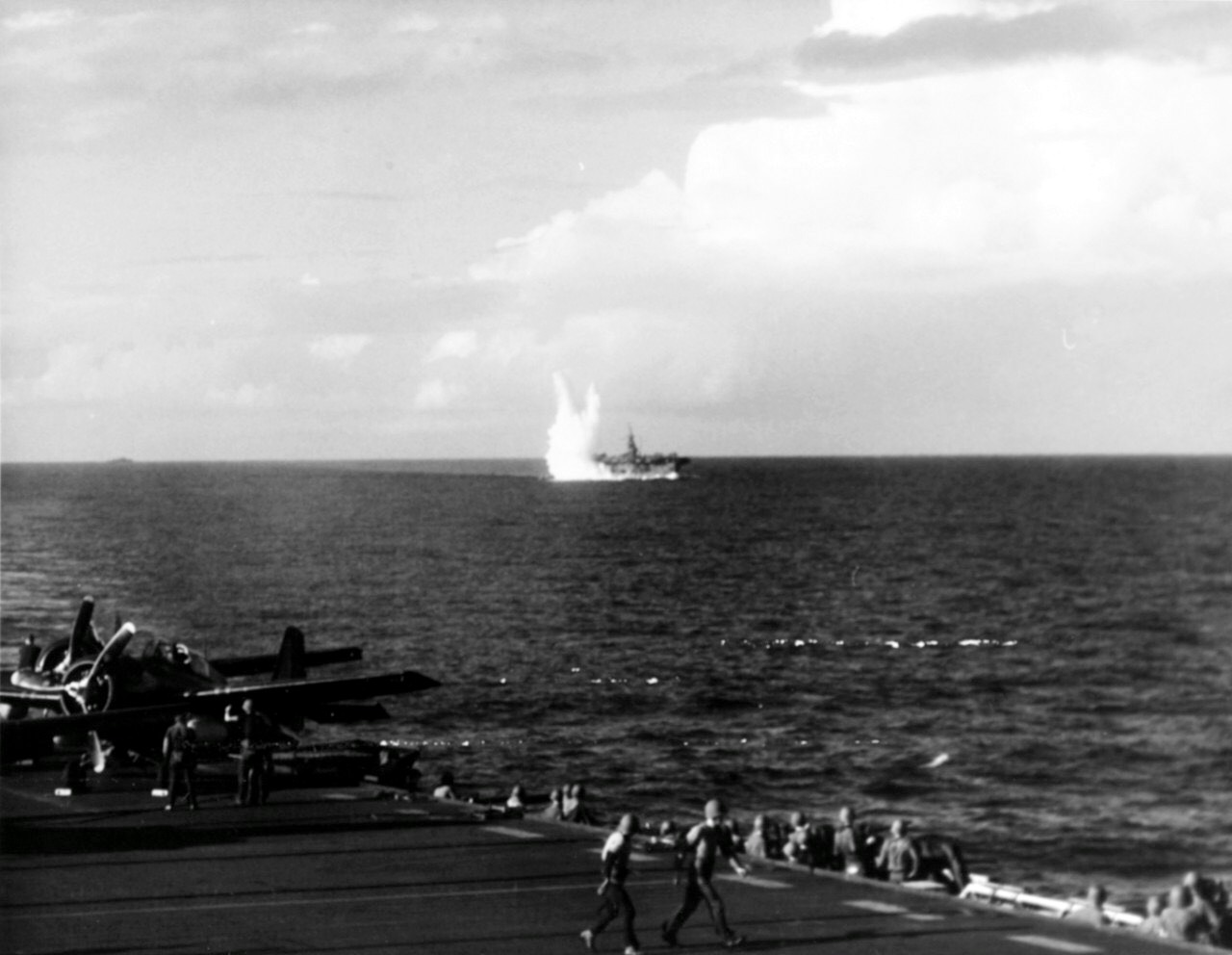
Immediately after the crash aboard Santee, another Kamikaze circled USS Suwanee (CVE-27). It was hit by antiaircraft gunfire and headed toward USS Sangamon (CVE-26). A 5-inch shell fired by Suwanee brought it down short of Sangamon. At the same time, another Kamikaze nearly hit USS Petroff Bay (CVE-80), a Casablanca-class escort carrier, but was shot down by antiaircraft fire.
Suwanee shot down a second Zero and damaged a third. This airplane rolled over, and trailing smoke, hit the escort carrier’s flight deck forward of the aft elevator. Its bomb exploded between the flight and hangar decks.
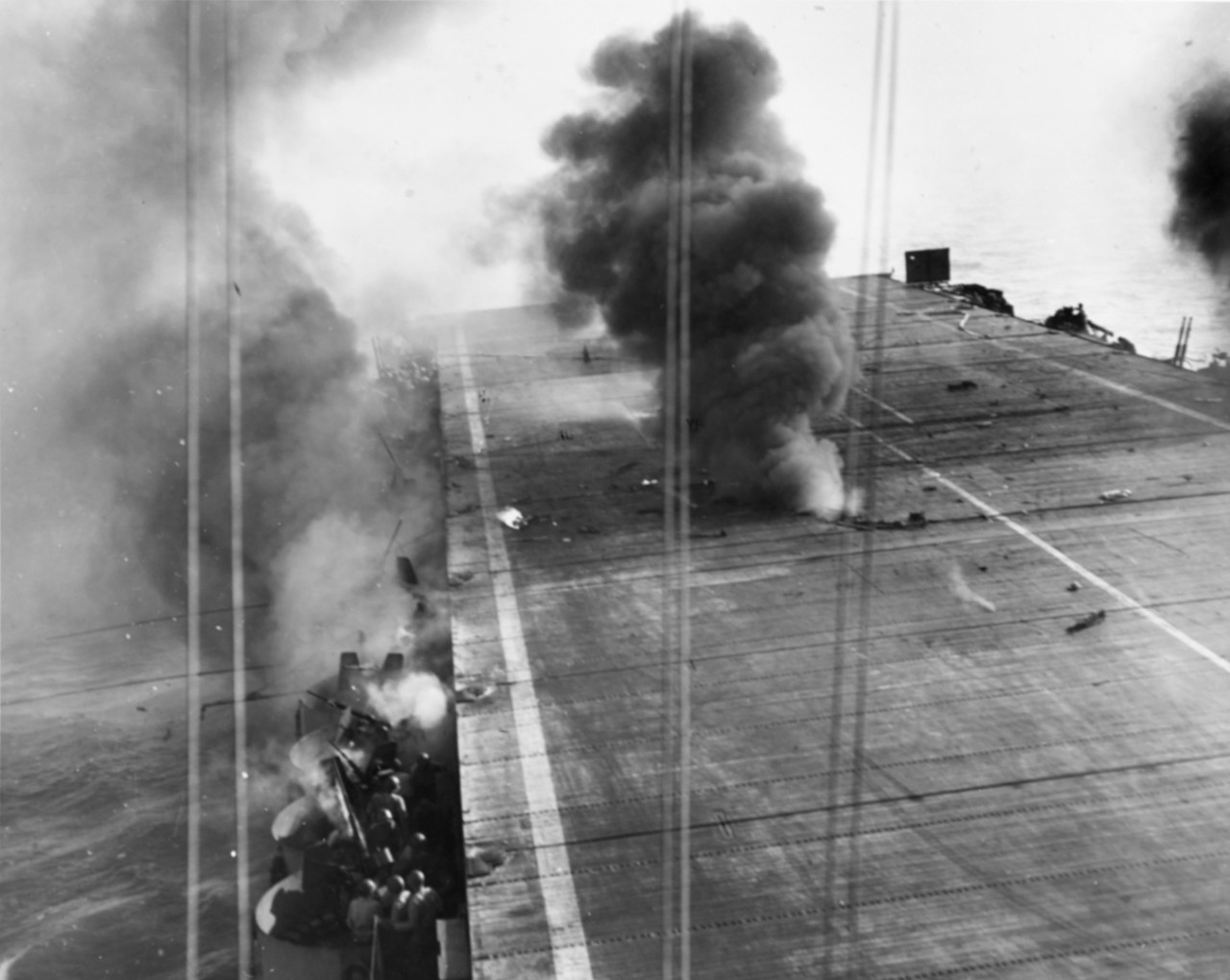
Within two hours the flight deck damage had been repaired, though the elevator remained inoperative. Flight operations resumed at 10:09 a.m.
Five Mitsubishi A6M2 Type 0 Model 21 Reisen fighters (commonly referred to as the “Zero”, and also known by the Allied reporting name Zeke) led by Lieutenant Seki departed Malabacat, Luzon, and headed toward Task Force 77.4.3 (“Taffy 3”), under the command of Rear Admiral Clifton Albert Frederick (“Ziggy”) Sprague, USN. (Ziggy Sprague was not related to Tommy Sprague.)
Prior to this mission, Lieutenant Seki was interviewed by war correspondent Masashi Onoda. Seki is reported to have said, “Japan’s future is bleak if it is forced to kill one of its best pilots. I am not going on this mission for the Emperor or for the Empire. . . I am going because I was ordered to!”
Most of Taffy 3 had just survived an attack by the Imperial Japanese Navy’s overwhelming Center Force, consisting of the Japanese super battleship Yamato, battleships Nagato, Kongo, Haruna, cruisers Haguro, Chokai, Kumano, Suzuya, Chikuma, Tone, and two destroyer squadrons, in The Battle off Samar.
The Kamikazes approached the task group at very low altitude, avoiding radar, then climbed to 5,000–6,000 feet (1,524–1,829 meters). They appeared so suddenly that the fleet’s combat air patrol was unable to intercept. At 10:50 a.m., the first Zero attacked USS Kitkun Bay (CVE-71), apparently aiming for the carrier’s bridge. It missed, but passed over the island, crashed the port catwalk, and bounced into the sea. The bomb it carried exploded and seriously damaged the ship.
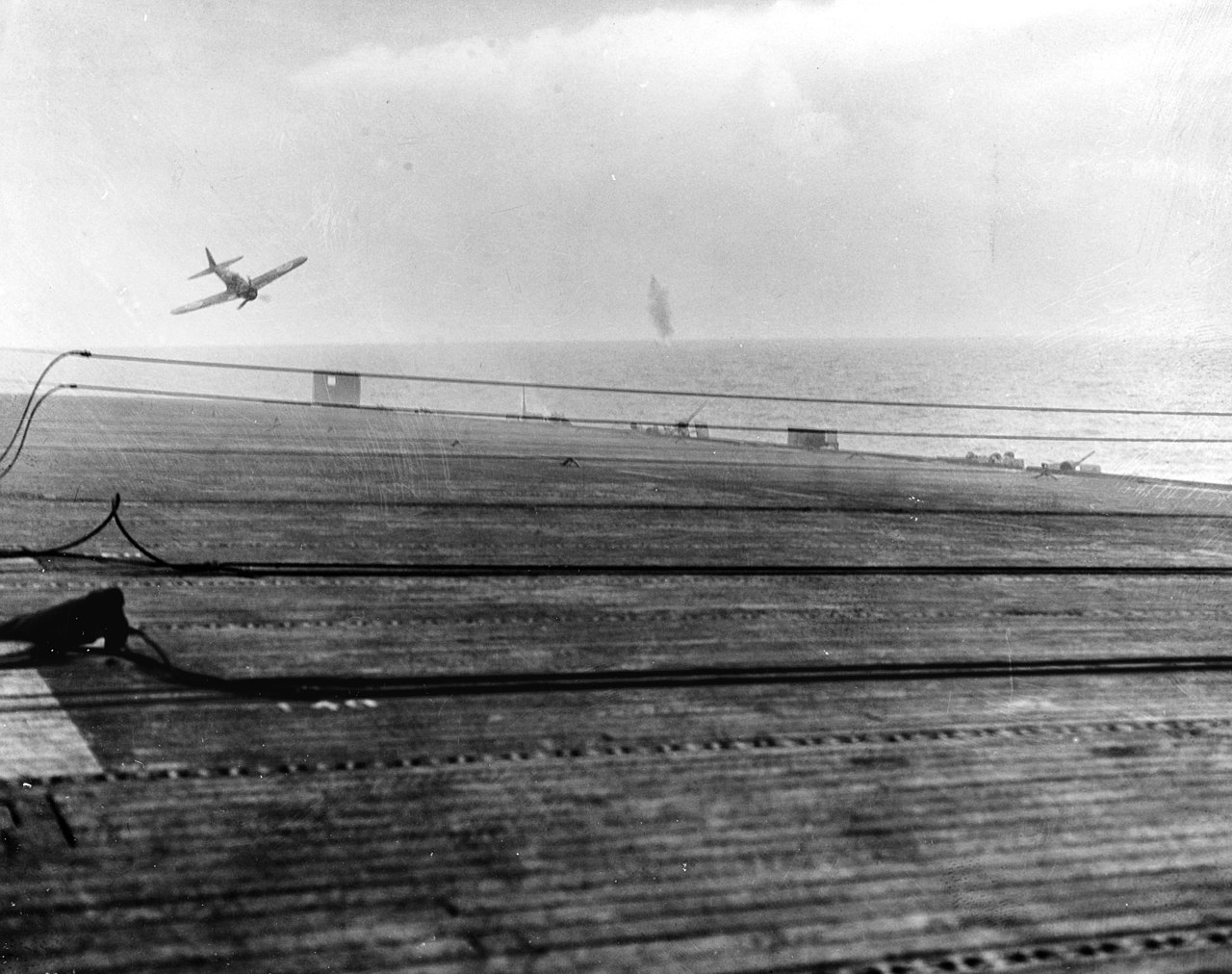
Two Zeros attacking USS Fanshaw Bay (CVE-70) were shot down. Two more dived on USS White Plains (CVE-66) but were driven off by the carrier’s 40 millimeter Bofors antiaircraft guns. One, smoking from a hit, turned away and dived toward the escort carrier USS St. Lo (CVE-63). At 10:51, St. Lo‘s guns opened fire, but this fighter, identified as a Mitsubishi A6M5 Type 0 Model 52 Reisen, crashed through the flight deck and exploded in flames.¹
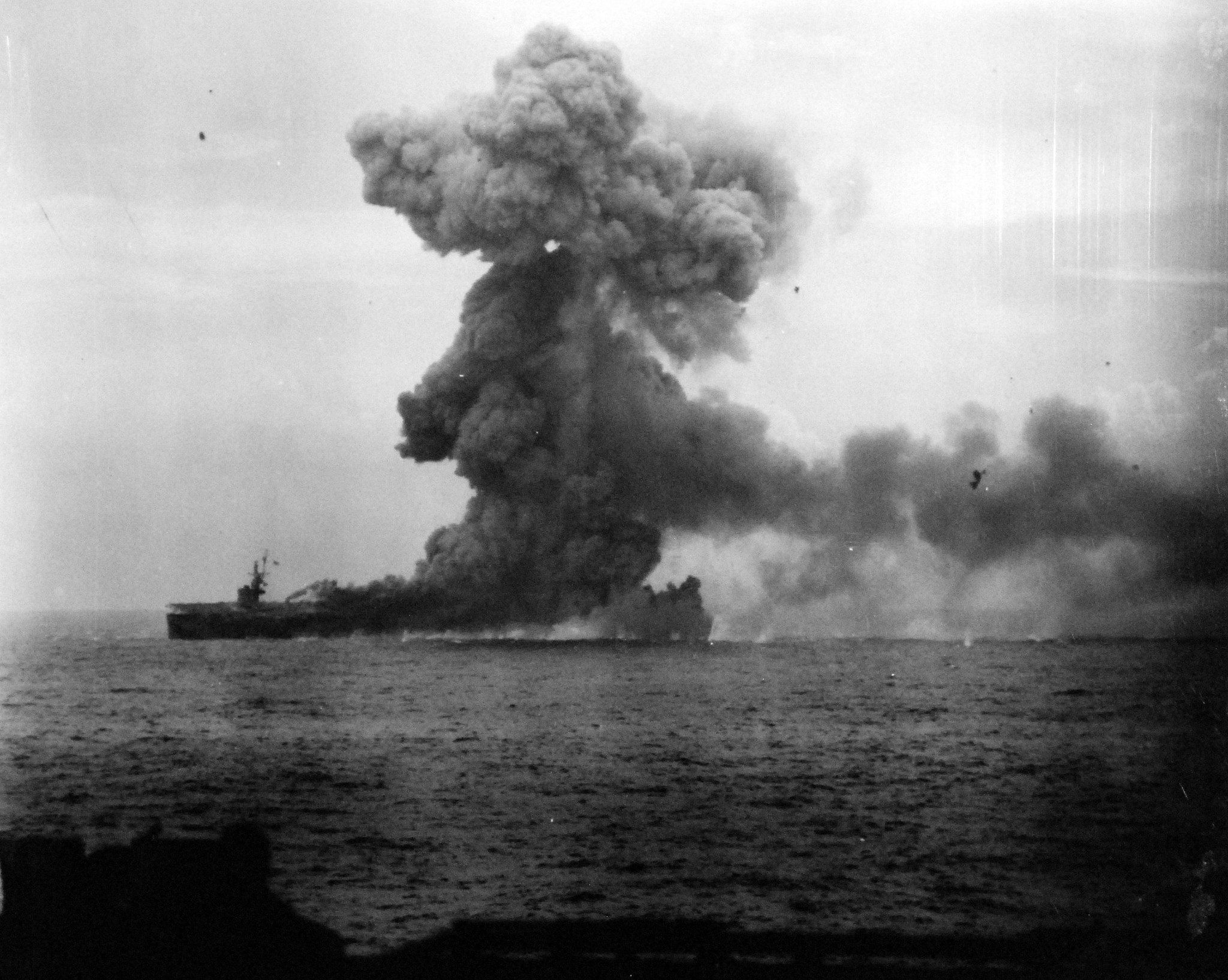
In his classic 15-volume History of United States Naval Operations in World War II, Rear Admiral Samuel Eliot Morison, USNR, describes what followed:
“Quickly there followed seven explosions of torpedoes and bombs on the hangar deck. Great sections of the flight deck and elevator and entire planes were hurled hundreds of feet into the air. The ship blazed from stem to stern, and at 1125 the unluckily renamed ² St. Lo foundered under a cloud of dense smoke.
“The second member of this pair partly circled the formation, turned, and started a run on White Plains, which maneuvered to evade with hard left rudder. The plane came weaving under fire of all after guns; a torrent of blazing tracers could be seen entering its fuselage and wing roots. When only a few yards astern, it rolled over and dove, missing the port catwalk by inches and exploding between that level and the water. The flight deck was showered with debris and fragments of the pilot, and eleven men were injured.
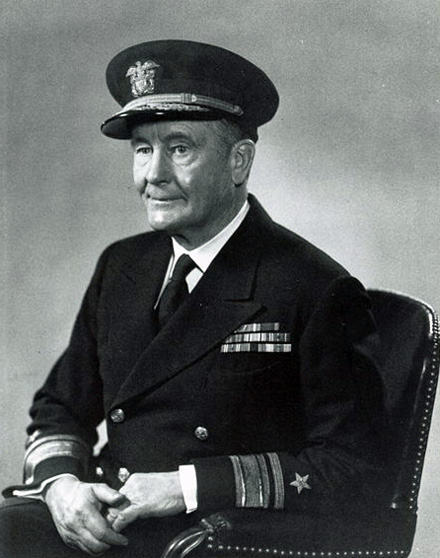
“As Kitkun Bay was steaming on course 200° at 1110, she sighted 15 Judys [Yokosuka D4Y Suisei dive bombers] approaching the formation from astern, distant about five miles. She launched two Wildcats by catapult for combat air patrol, but not in time. She and the three remaining carriers, Fanshaw Bay, White Plains and Kalinin Bay were without screen, owing to rescue work. One of the three Kamikazes got through the C.A.P. and dove at Kitkun Bay from astern. Its wings were shot off as it neared the ship, and just in time, for the bomb struck the water 25 yards on the starboard bow and parts of the plane hit the forecastle. Kalinin Bay received a crash dive on her flight deck which damaged it badly, but the fires then started were quenched in less than five minutes. A second plane crashed after her stack and two others dove but missed. Admiral Sprague’s flagship, the lucky “Fannie Bee,” alone alone sustained no damage in this assault.”
—History of United States Naval Operations in World War II, Volume XII, Leyte—June 1944–January 1945, by Rear Admiral Samuel Elliot Morison, USNR. Chapter XIII, Section 3, at Page 302. Little, Brown and Company, Boston, 1988
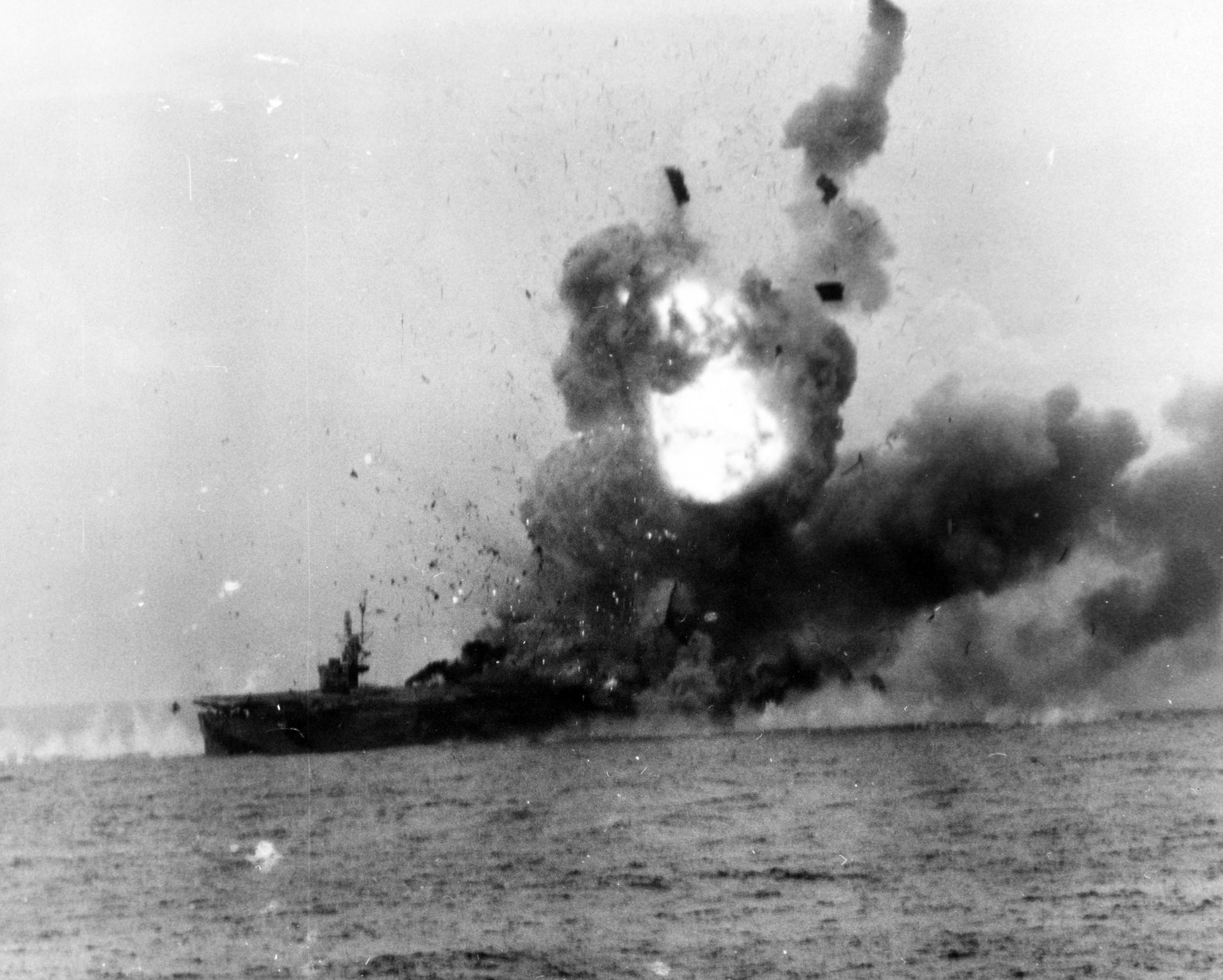
Of St. Lo‘s crew of 889 men, 113 were killed or missing, and another 30 later died of wounds.
Taffy 3’s remaining screening ships,³ the Fletcher-class destroyer USS Heerman (DD-531), with the Butler-class destroyer escorts USS John C. Butler (DE-339), USS Dennis (DE-405) and USS Raymond (DE-341), searched for survivors of the sunken St. Lo. They recovered 754 men.
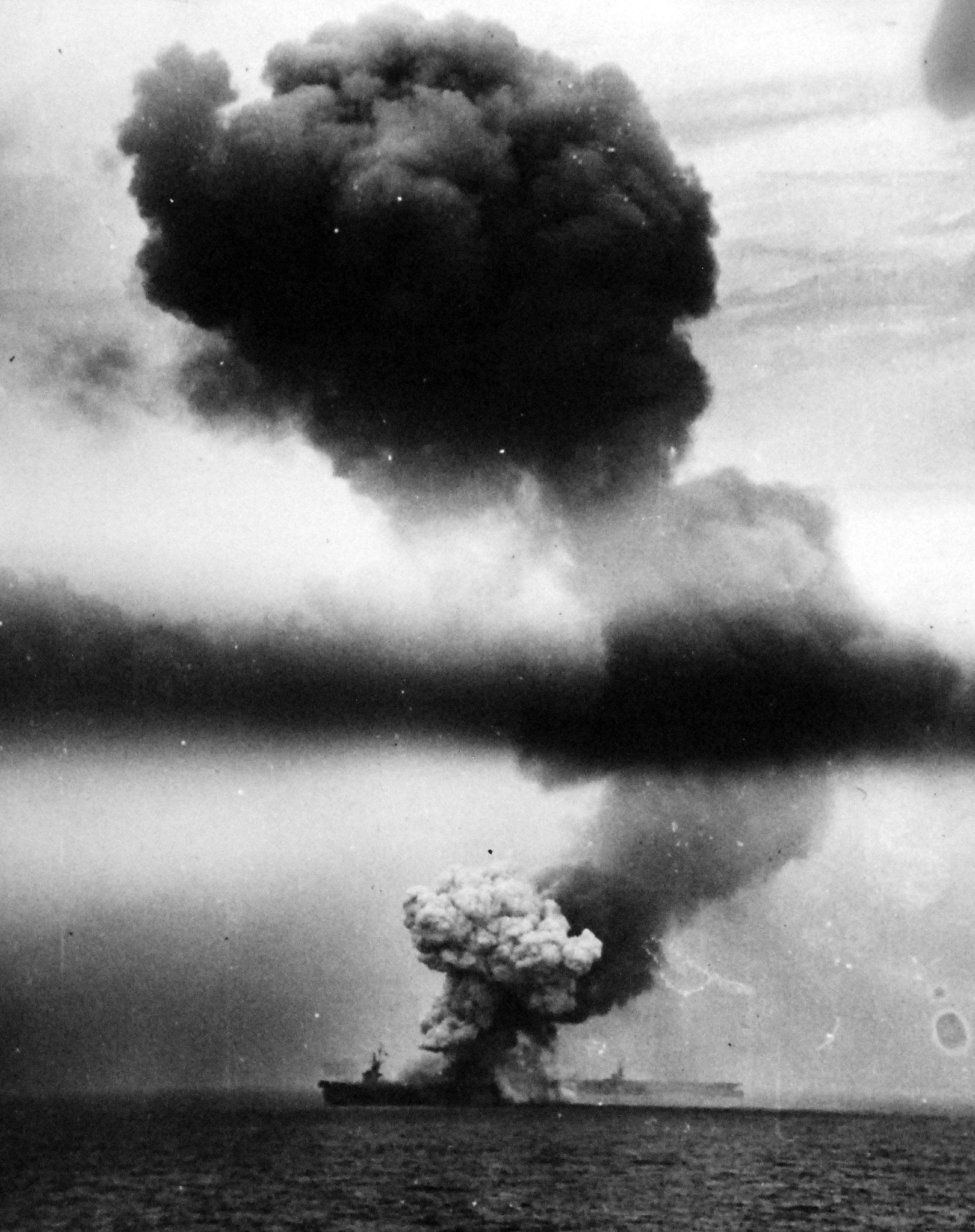
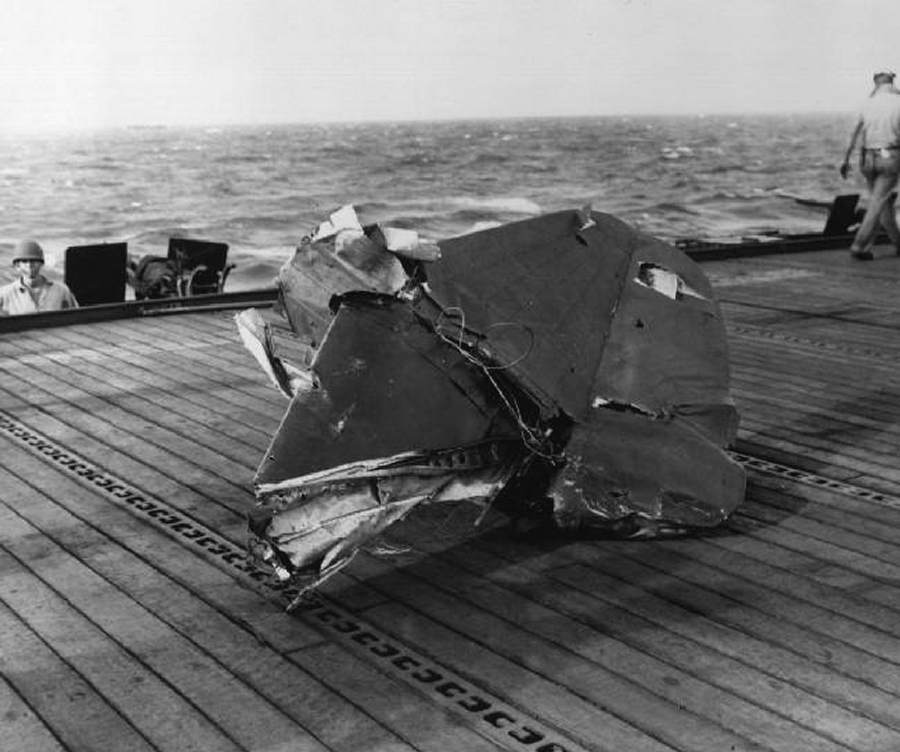
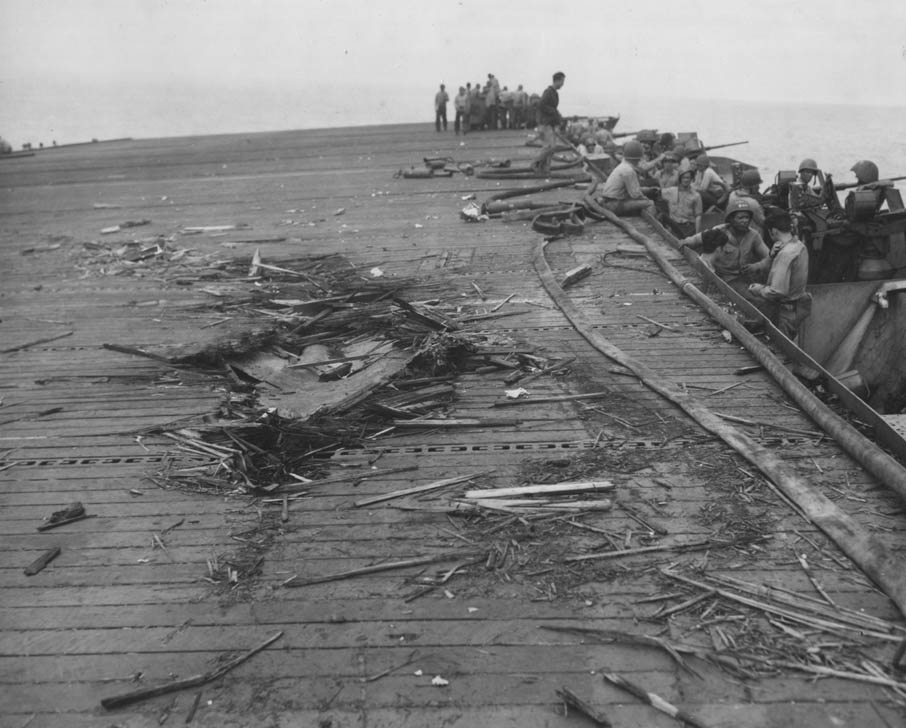
Just after noon on 26 October, another group of Kamikazes attacked Taffy 1. The task group’s combat air patrol saved Santee from 12 Judys. Sangamon and Petroff Bay were narrowly missed.
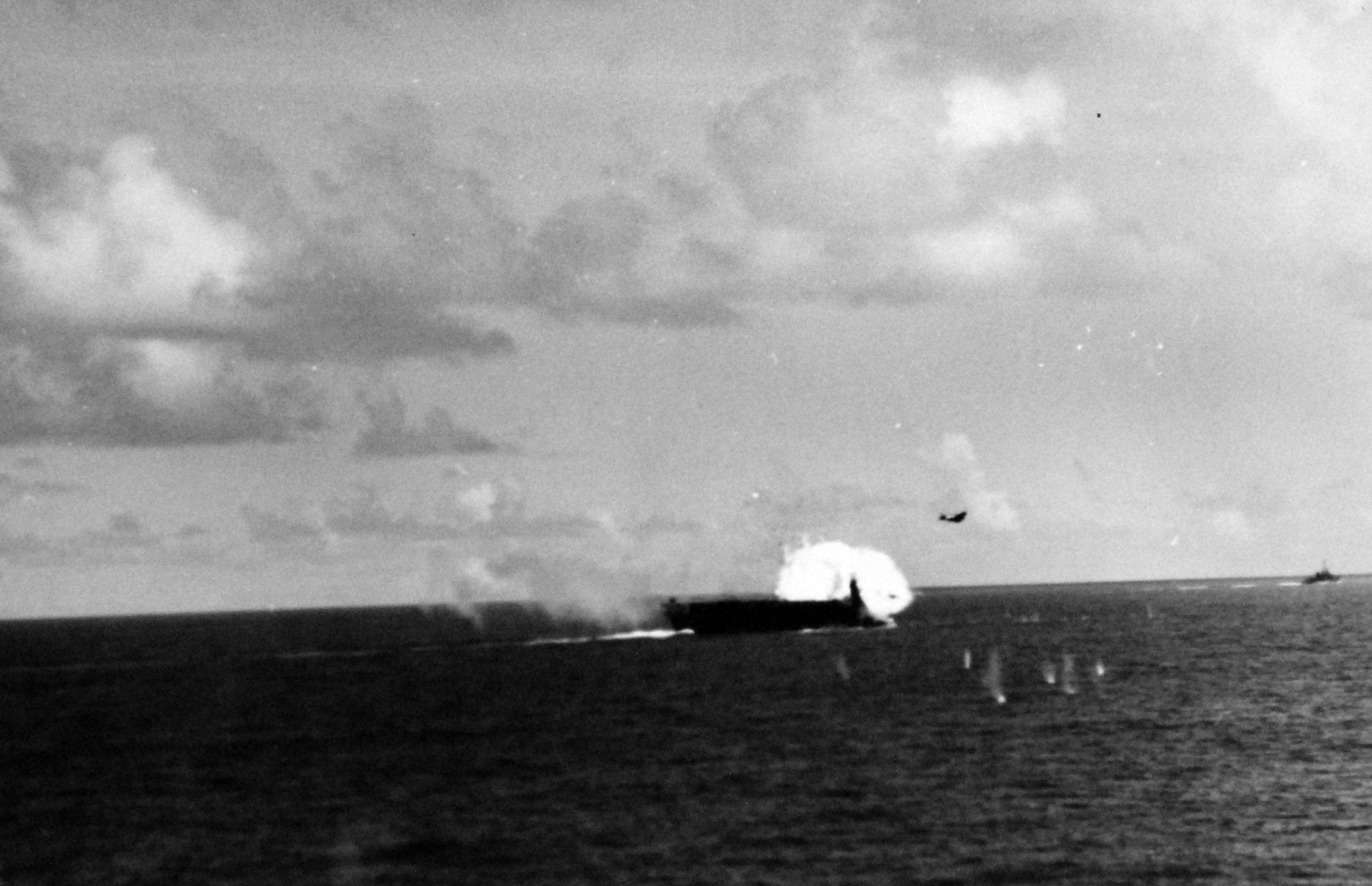
At 12:40 p.m., a Zero crashed onto Suwanee‘s flight deck and hit a torpedo bomber which had just landed. Both airplanes exploded. Nine more of Suwannee‘s airplanes caught fire. 85 sailors were killed, 58 were missing and 102 wounded, some of whom later died of their injuries.
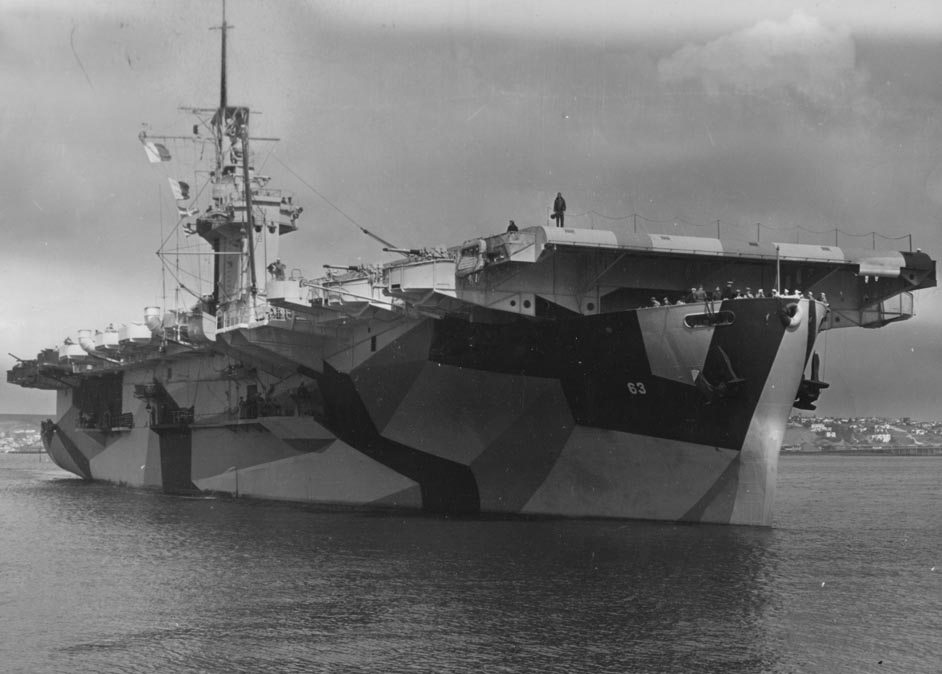
USS St. Lo (CVE-63) was a Casablanca-class escort aircraft carrier. Originally designated an auxiliary aircraft carrier, USS Chapin (ACV-63), the ship was laid down by the Kaiser Shipbuilding Co., Vancouver, Washington, 23 January 1943, under a Maritime Commission contract (M.C. Hull 1100). Chapin was renamed USS Midway (CVE-63) on 3 April 1943.
Midway was launched 17 August 1943, and commissioned 23 October 1943. Captain Francis Joseph McKenna, USN, was in command. The ship cost $6,033,429.05.
On 10 October 1944, Midway was renamed USS St. Lo (CVE-63), just 15 days before she was sunk.
St. Lo had an overall length 512 feet, 3 inches (156.14 meters), beam of 65 feet, 2 inches (19.86 meters) and maximum draft of 22 feet 4 inches (6.81 meters). The extreme width of the flight deck was 108 feet, 1 inch (32.95 meters). The ship had a full load displacement of 10,902 long tons (11,077 metric tons). It was powered by four Babcock & Wilcox boilers of 9,000 shaft horsepower (6,700 kilowatts), feeding two Skinner Unaflow vertical reciprocating steam engines, which turned two screws capable of driving it at 19 knots (22 statute miles per hour/35 kilometers per hour). The carrier had an unrefueled range of 10,240 nautical miles (11,784 statute miles/18,965 kilometers) at 15 knots (17 statute miles per hour/28 kilometers per hour).
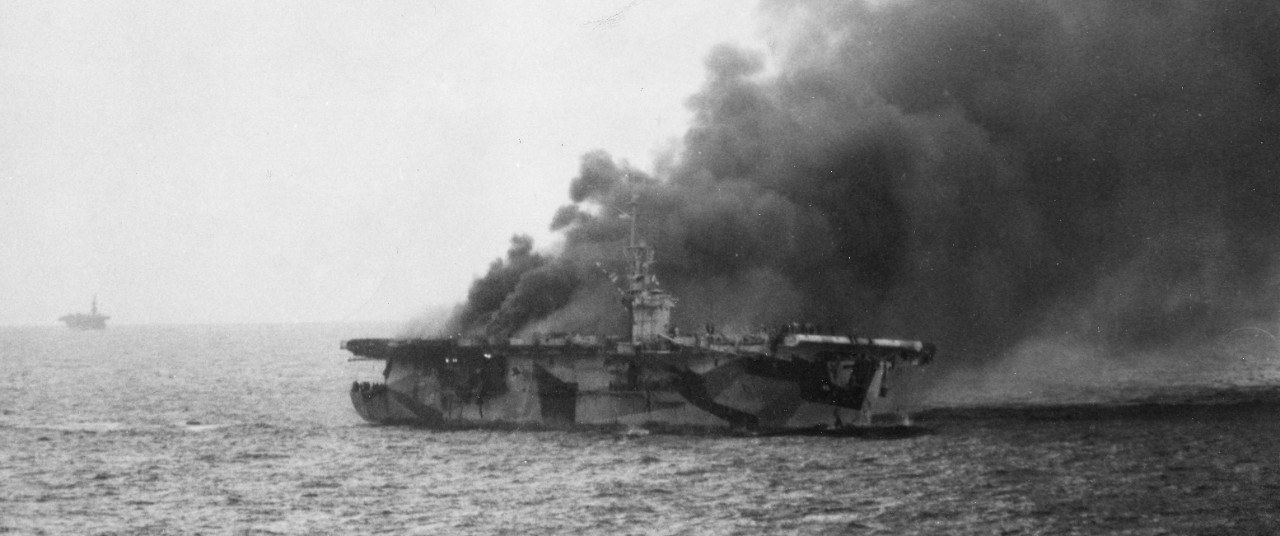
The flight deck was equipped with one steam catapult and two elevators.
St. Lo was armed by one 5-inch, 38-caliber (127 millimeter) dual purpose naval gun, sixteen 40 millimeter Bofors automatic antiaircraft guns, and twenty 20 millimeter Oerlikon autocannon. She carried 672 rounds of 5-inch, 3,298 rounds of 40 millimeter cannon shells, and 7,440 rounds of 20 millimeter shells. The carrier also carried 1,350 rounds of .45 ACP small arms ammunition.⁴
St. Lo carried 27 aircraft, including Grumman F4F or General Motors/Eastern Aircraft FM Wildcat fighters and Grumman TBF or General Motors TBM Avenger torpedo bombers.
The wreck of USS St. Lo is located near N. 11° 1′ 12″, E. 126° 2′ 24″.
¹ Historian John Toland named Lieutenant Seki as the pilot of this airplane, but Lieutenant Junior Grade Hiroshi Nishizawa, IJN, flying one of the A6M5 escorting fighters, reported that Seki’s airplane bounced off the deck of the carrier and its bomb did not explode. It crashed into the sea. He observed a second plane crash onto St. Lo, and its bomb did explode. Nishizawa was killed the following day, 26 October 1944.
² It is an old sailors’ superstition that it is unlucky to rename a ship. USS St. Lo had been laid down as USS Chapin Bay in January 1943. On 3 April 1943, it was renamed USS Midway. In order to free the name Midway for the new large aircraft carrier CVB-41, as well to commemorate the Battle of Saint-Lô, USS Midway was renamed USS St. Lo on 10 October 1944.
³ Along with USS Gambier Bay (CVE-73), Taffy 3’s escorting Fletcher-class destroyers, USS Hoel (DD-503) and USS Johnston (DD-557) and the Butler-class destroyer escort, USS Samuel B. Roberts (DE-413), were sunk several hours earlier by enemy naval gunfire during The Battle off Samar, when they heroically counterattacked the Center Force.
⁴ Naval History and Heritage Command, “Midway II (CVE-63)”
© 2023, Bryan R. Swopes
Hello ,
I have read discussion of photographs of the under-keel damage done to USS White Plains during this battle .
I would greatly appreciate any information referencing a source for such photos .
Thanks ,
Derek Hendricks
I did not find any photographs of damage to USS White Plains. All the photographs in the article were found on the Internet. The captions include source information.